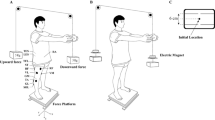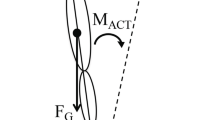Abstract
The aim of the study was to examine whether infants, at an age when they have no or little experience in sitting, can produce direction specific postural adjustments, i.e. synergies of muscle activity on the ventral side of the body during backward sway and on the dorsal side during forward sway. In addition, we addressed the question whether postural adjustments at this young age are restricted to single muscle responses or consist of a variable repertoire of muscle activation patterns including one during which all direction specific muscles participate (‘complete’ pattern). Postural adjustments due to external perturbations in a sitting position were studied in eight healthy infants aged 1 month. Multiple surface EMGs of neck, trunk and leg muscles and kinematics were recorded while the infants were exposed to horizontal forward (Fw) and backward (Bw) displacements of the surface of support. Direction specific postural adjustments, defined as adjustments during which agonist activation or antagonist inhibition preceded antagonist activation, were present in 85% of Bw and 72% of Fw translations. The direction specific adjustments showed a large variability with the repertoire of adjustments including the activation of one, two or all of the recorded direction specific muscles. The finding of direction specific adjustments at 1 month of age support the opinion that the basic level of organisation of postural adjustments has an innate origin. The finding of a variable repertoire of muscle response patterns, including the ‘complete’ pattern, refutes the idea that the development of postural adjustments results from gradual addition of appropriate muscles to the synergies.




Similar content being viewed by others

References
Bloem BR, Allum JHJ, Carpenter et al. (2000) Is lower leg proprioception essential for triggering human automatic postural responses? Exp Brain Res 130:375–391
Cordo PJ, Nashner LM (1982) Properties of postural adjustments associated with rapid arm movements. J Neurophysiol 47:287–302
Dietz V (1992) Human neuronal control of automatic functional movements: interaction between central programs and afferent input. Physiol Rev 72:33–69
Dietz V (1998) Evidence for a load receptor contribution to the control of posture and locomotion. Neurosci Biobehav Rev 22:495–499
Edin B (2001) Cutaneous afferents provide information about knee joint movements in humans. J Physiol 531:289–297
Forssberg H (1999) H Neural control of human motor behaviour. Curr Opin Neurobiol 9:676–682
Forssberg H, Hirschfeld H (1994) Postural adjustments in sitting humans following external pertubations: muscle activity and kinematics. Exp Brain Res 97:515–527
Hadders-Algra M (2000) The neuronal group selection theory: an attractive framework to explain variation in normal motor development. Dev Med Child Neurol 42:566–572
Hadders-Algra M, Brogren E, Forssberg H (1996a) Ontogeny of postural adjustments during sitting in infancy: variation, selection and modulation. J Physiol 493:273–288
Hadders-Algra M, Brogren E, Forssberg H (1996b) Training affects the development of postural adjustments in sitting infants. J Physiol 493:289–298
Hadders-Algra M, Klip-Van den Nieuwendijk, Martin A, Van Eykern LA (1997) Assessment of general movements: towards a better understanding of a sensitive method to evaluate brain function in young infants. Dev Med Child Neurol 39:88–98
Harbourne RT, Guiliani C, MacNeela J (1993) A kinematic and electromyographica analysis of the development of sitting posture in infants. Dev Psychobiol 26:51–64
Hirschfeld H, Forssberg H (1994) Epigenetic development of postural responses for sitting during infancy. Exp Brain Res 97:528–540
Horak FB, Nashner LM (1986) Central programming of postural movements: adaptation to altered support-surface configurations. J Neurophysiol 55:1369–1381
Kavounoudias A, Roll R, Roll J-P (2001) Footsole and ankle muscle inputs contribute jointly to human erect posture regulation. J Physiol 532.3:869–878
Keshner EA, Woollacott MH, Debû B (1988) Neck, trunk and limb muscle responses during postural perturbations in humans. Exp Brain Res 71:455–466
Macpherson JM (1994) Changes in postural strategy with interpaw distance. J Neurophysiol 71:931–940
Massion J (1994) Postural control system. Curr Opin Neurobiol 4:877–887
Olausson H, Wessberg J, Kakuda N (2000) Tactile directional sensibility: peripheral neural mechanisms in man. Brain Res 866:178–187
Prechtl HFR (1989) Development of postural control in infancy. In: von Euler C, Forssberg H, Lagercrantz H (eds) Neurobiology of early infant behaviour. Wenner-Gren International Symposium Series, London, pp 59–76
Touwen BCL (1976) Neurological development in infancy. In: Clinics in developmental medicine no. 59. Heinemann Medical Books, London
Van der Fits IBM, Klip AWJ, Van Eykern LA, Hadders-Algra M (1999) Postural adjustments during spontaneous and goal-directed arm movements in the first half year of life. Behav Brain Res 106:75–90
Woollacott M, Debû B, Mowatt M (1987) Neuromuscular control of posture in the infant and child: is vision dominant.? J Motor Behav 19:167–186
Acknowledgement
We thank Eva Brogren-Carlberg for her valuable support during data collection as well as her methodological advice.
Author information
Authors and Affiliations
Corresponding author
Additional information
The study was supported financially by Folke Bernadotte Stiftelsen, Linnéa och Josef Carlssons Stiftelse, Norrbacka-Eugeniastiftelsen, Riksförbundet för Rörelsehindrade Barn och Ungdomar and Sunnerdahls Handikappfond
Electronic Supplementary Material
Rights and permissions
About this article
Cite this article
Hedberg, Å., Forssberg, H. & Hadders-Algra, M. Postural adjustments due to external perturbations during sitting in 1-month-old infants: evidence for the innate origin of direction specificity. Exp Brain Res 157, 10–17 (2004). https://doi.org/10.1007/s00221-003-1811-z
Received:
Accepted:
Published:
Issue Date:
DOI: https://doi.org/10.1007/s00221-003-1811-z



